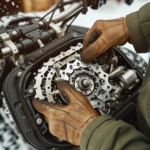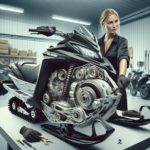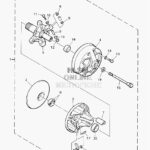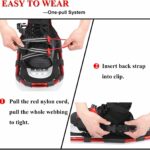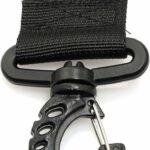Looking to tackle a winter project? Maybe you’re a seasoned snowmobile enthusiast eager to handle your own maintenance, or perhaps you’re a novice getting behind the mechanics of your newest hobby. Either way, if you’re here to learn about removing a clutch on a snowmobile, you’re in luck. This step-by-step guide will take you through the process in a thorough yet easy-to-understand manner, aiding you in mastering this imperative and empowering skill. So grab your tools, pull up your chair, and get ready to gain some hands-on knowledge. You’ll be getting your snowmobile ride-ready in no time.
Tools and safety gear
Before diving into the detailed process of how to remove a clutch on a snowmobile, it’s crucial to talk about the importance of having the right tools and safety gear. The quality of your work greatly depends on these two critical components.
Identifying appropriate tools for the job
Believe it or not, but using inappropriate tools can not only make the job harder but also potentially damage the parts you’re working on – and that’s definitely not what you want when dealing with something as critical as your snowmobile’s clutch. For this job, you might need common tools like a ratchet set, metric socket set, and wrenches, but also specialist tools like a clutch puller specific to your snowmobile’s model. Always remember to double-check that you have all the necessary tools before you start.
Ensuring safety gear is worn, including gloves and safety glasses
When working on any mechanical project, personal safety should be your number one priority. This means wearing the proper safety gear. We recommend thick work gloves to protect your hands from any sharp components or heavy tools and safety glasses to shield your eyes from potentially harmful debris. This may seem like an unnecessary precaution, but remember that it’s always better to be safe than sorry.
Understanding the Functioning of the Clutch
Understanding the functioning of the clutch is an important step in removing it. The better you understand how it works, the more comfortable you’ll be when it comes to disassembling it.
Components of the clutch
A snowmobile clutch is comprised of several parts including the clutch body or clutch hub, the sheaves that can come together or move apart, the weights, and springs. It’s very similar to a bicycle gear system where the moving parts help transmit power from the engine to the drivetrain.
How the clutch works in a snowmobile
In a snowmobile, the clutch works as an automatic transmission. It transmits power from the engine to the snowmobile’s track. As the engine speeds up, the clutch weights open up, allowing the sheaves to come closer together, which in turn increases the snowmobile’s speed. While the mechanics may seem a bit complex at first, don’t worry. You’ll get the hang of it soon enough.
Locating the Clutch
Before removing the clutch, you first need to locate it. This might seem like an obvious step, but it can be more challenging than you might initially think.
Identifying clutch location within snowmobile
The clutch in a snowmobile is usually located on the engine’s right side, connected to the engine via a crankshaft. Its position can vary depending on the snowmobile’s model, but once you locate the drive belt – which connects the clutch and secondary drive directly – you’ll find the clutch nearby.
Accessing the clutch
To access the clutch, you’ll likely need to remove the snowmobile’s side panel. Ensure you handle the panel with care to prevent any damages. Some more modern snowmobiles might have easy access points that allow you to reach the clutch without removing significant parts.
Preparation for Removal
The goal is to remove the clutch safely and without causing damage. That means carrying out a few preparatory steps.
Switching off snowmobile and disconnecting the battery
First, it’s crucial that you switch off the snowmobile and disconnect the battery. This step is necessary to prevent any electrical accidents during the process of removing the clutch.
Allowing engine to cool prior to commencement
For your safety and to prevent any damage to parts, allow the engine to cool if you’ve just used the snowmobile. This way, you’ve removed any risk of burns from hot engine parts.
Disengaging the Belt
The next step is to disengage the drive belt, which is directly connected to the clutch.
Identifying the drive belt
Identifying the belt should be relatively easy since it’s the wide, black, rubbery ring connecting the primary clutch to the secondary drive. It plays an important role in transferring power from the engine to the drivetrain.
Instructions for properly disengaging the belt
Disengaging the belt usually involves loosening the belt tension bolt, allowing the clutch sheaves to separate enough for the belt to slip off. Be careful not to tear or damage the belt in the process, as it’s an expensive component to replace.
Removing the Clutch Bolts
Next, you’ll need to remove the clutch bolts.
Locating clutch bolts
The clutch bolts are typically located on the clutch’s face, holding it onto the engine crankshaft. Be sure to identify all of them before starting the removal process.
Techniques for loosening and removing clutch bolts
Using your socket wrench, you can loosen and remove the bolts. Occasionally, you might encounter a stubborn bolt. In such scenarios, applying some penetrating oil can help loosen it. Remember to keep track of all bolts and where they belong to ensure a smooth reassembly process.
Taking off the Clutch
Once the bolts are removed, you can proceed to take off the clutch.
Steps for removing clutch from its housing
To remove the clutch, you’ll need a specialty clutch puller. Attach the puller to the clutch using the bolts you just removed, then, using the wrench, degree it. The clutch should slide off the crankshaft. If not, do not force or hammer it as this could cause damage. Instead, apply heat to the clutch hub to expand the clutch slightly for easier removal.
Handling clutch components with care
Remember, many components in the clutch are delicately balanced and sensitive to distortion. Be gentle in your handling, and do not drop or knock the clutch as this could potentially result in significant damage that impacts the performance of your snowmobile.
Handling Disassembled Parts
After putting in the hard work of removing the clutch, it’s important to take care of the disassembled parts properly.
Organizing removed parts
Each part from the clutch system should be placed neatly in a systematic order, which will make the reassembly process more manageable. You could also label the parts to avoid any confusion when putting everything back together.
Properly storing parts for reassembly
Store the parts in a clean, dry place to prevent dust or moisture build-up, which could cause rusting or corrosion. Also, be careful to not lose any smaller parts like the bolts.
Reassembly of the snowmobile
After successfully removing and inspecting or fixing the clutch, you’ll need to reassemble the snowmobile.
Guidance for reassembling the snowmobile
Reassembly primarily consists of retracing your earlier steps in reverse. Make sure you keep your bolts and other parts organized as you go along, and don’t rush the process. Reassembly can sometimes be trickier than disassembly, so it’s absolutely crucial to be meticulous.
Checklist to ensure all parts are secure
Once you’ve reassembled everything, double-check each part to ensure it’s secure. This includes making sure every bolt is tightened and every component is correctly aligned before you attempt to start the snowmobile.
Maintenance and Clutch Health
Now that you’ve successfully removed and replaced your snowmobile’s clutch, let’s discuss the importance of routine checks and maintenance.
Routine checks to perform for clutch health
Regularly inspect the belt, weights, and springs, as these are the components that wear out the most frequently. Also, listen for any unusual sounds when the snowmobile is running; this could be an early sign of a potential problem.
Tips for maintaining snowmobile clutch
Regular checks and simple maintenance operations like cleaning and lubricating are often sufficient to keep your snowmobile’s clutch in good working condition. Also, always remember to read the user manual for specific maintenance instructions for your particular model.
There you have it! We’ve walked through the process of how to remove a clutch on a snowmobile. Remember, safety first, and don’t rush the process. Good luck, and here’s to many more safe and enjoyable rides on your snowmobile!
- What Snowboard Bindings Should I Get? - January 23, 2024
- What Size Screws For Snowboard Bindings? - January 23, 2024
- How To Snowmobile On Water? - January 23, 2024


